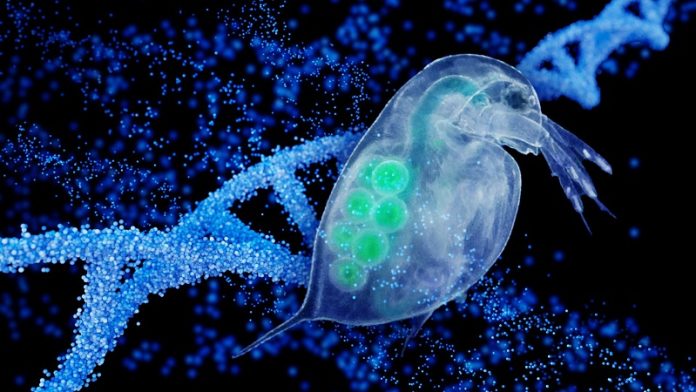
In a groundbreaking study, scientists from Arizona State University (ASU) and their collaborators have discovered new insights into evolution by studying a tiny creature called the water flea, or Daphnia pulex.
This research challenges traditional views on how genetic changes occur over time and highlights the complexity of natural selection.
Daphnia pulex, a small crustacean barely visible to the naked eye, plays a crucial role in freshwater ecosystems.
They serve as a vital food source for fish and help control algae growth. Additionally, Daphnia are valuable for scientific research due to their quick reproductive cycle and sensitivity to environmental changes.
Led by Professor Michael Lynch, the team conducted a decade-long study using advanced genomic techniques to analyze DNA samples from nearly 1,000 Daphnia.
Their findings, published in the journal Proceedings of the National Academy of Sciences, reveal that natural selection on individual genes varies significantly from year to year.
This variation helps maintain genetic diversity, allowing populations to adapt to changing environmental conditions.
The study found that even in seemingly stable environments, there are significant fluctuations in the frequency of gene variants, known as alleles, over time.
These changes suggest that genetic variation enables populations to remain adaptable, providing raw material for natural selection to act upon.
“This study has, for the first time, given us a glimpse into the kinds of temporal changes in gene frequencies that occur even in seemingly constant environments,” says Michael Lynch, director of the Biodesign Center for Mechanisms of Evolution at ASU.
Daphnia have long fascinated biologists due to their crucial role in aquatic ecosystems and their ability to adapt to environmental stressors. They are also widely used for freshwater toxicity testing because they reproduce rapidly and are sensitive to various pollutants.
The researchers discovered that most genetic sites on the Daphnia genome experience changing selection pressures over time. On average, these pressures balance out, meaning no single direction of selection consistently dominates. Instead, the advantages or disadvantages of specific traits change from one period to the next.
These findings challenge the traditional belief that measuring genetic diversity and genetic differences between populations can easily show how natural selection is operating. Instead, natural selection appears to be more subtle and complex than previously thought.
The study also revealed that genes located near each other on chromosomes tend to evolve together. This linkage allows beneficial combinations of gene variants to be inherited together, potentially speeding up adaptation. However, it can also cause harmful alleles to increase in frequency, reducing the overall efficiency of natural selection.
This research shows that evolution is more dynamic and complex than previously appreciated. The frequent changes in environmental influence on genes help species maintain the genetic variety needed to adapt to future conditions.
While the study focused on Daphnia pulex, the findings may have broader implications for understanding how other species might respond to rapid environmental changes, including those driven by human activities like pollution and climate change. Understanding how Daphnia evolve could provide insights into the resilience of entire ecosystems, helping researchers predict and mitigate the impacts of environmental changes on biodiversity and food webs.
As the world faces accelerating environmental challenges, studies like this one provide crucial insights into nature’s capacity for resilience and adaptation. By continuing to study these tiny creatures, scientists hope to better understand the fundamental mechanisms of evolution and apply these lessons to broader ecological and conservation efforts.



